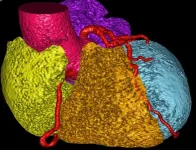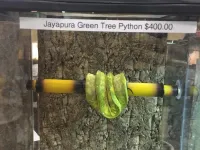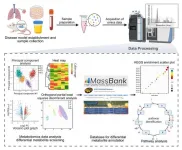(Press-News.org) A new study from Oxford University has uncovered why the deep neural networks (DNNs) that power modern artificial intelligence are so effective at learning from data. The new findings demonstrate that DNNs have an inbuilt ‘Occam's razor,’ meaning that when presented with multiple solutions that fit training data, they tend to favour those that are simpler. What is special about this version of Occam’s razor is that the bias exactly cancels the exponential growth of the number of possible solutions with complexity. The study has been published today (14 Jan) in Nature Communications.
In order to make good predictions on new, unseen data - even when there are millions or even billions more parameters than training data points - the researchers hypothesised that DNNs would need a kind of ‘built-in guidance’ to help them choose the right patterns to focus on.
“Whilst we knew that the effectiveness of DNNs relies on some form of inductive bias towards simplicity – a kind of Occam’s razor – there are many versions of the razor. The precise nature of the razor used by DNNs remained elusive” said theoretical physicist Professor Ard Louis (Department of Physics, Oxford University), who led the study.
To uncover the guiding principle of DNNs, the authors investigated how these learn Boolean functions – fundamental rules in computing where a result can only have one of two possible values: true or false. They discovered that even though DNNs can technically fit any function to data, they have a built-in preference for simpler functions that are easier to describe. This means DNNs are naturally biased towards simple rules over complex ones.
Furthermore, the authors discovered that this inherent Occam’s razor has a unique property: it exactly counteracts the exponential increase in the number of complex functions as the system size grows. This allows DNNs to identify the rare, simple functions that generalise well (making accurate predictions on both the training data and unseen data), while avoiding the vast majority of complex functions that fit the training data but perform poorly on unseen data.
This emergent principle helps DNNs do well when the data follows simple patterns. However, when the data is more complex and does not fit simple patterns, DNNs do not perform as well, sometimes no better than random guessing. Fortunately, real-world data is often fairly simple and structured, which aligns with the DNNs' preference for simplicity. This helps DNNs avoid overfitting (where the model gets too ‘tuned’ to the training data) when working with simple, real-world data.
To delve deeper into the nature of this razor, the team investigated how the network's performance changed when its learning process was altered by changing certain mathematical functions that decide whether a neuron should ‘fire’ or not.
They found that even though these modified DNNs still favour simple solutions, even slight adjustments to this preference significantly reduced their ability to generalize (or make accurate predictions) on simple Boolean functions. This problem also occurred in other learning tasks, demonstrating that having the correct form of Occam’s razor is crucial for the network to learn effectively.
The new findings help to ‘open the black box’ of how DNNs arrive at certain conclusions, which currently makes it difficult to explain or challenge decisions made by AI systems. However, while these findings apply to DNNs in general, they do not fully explain why some specific DNN models work better than others on certain types of data.
Christopher Mingard (Department of Physics, Oxford University), co-lead author of the study, said: “This suggests that we need to look beyond simplicity to identify additional inductive biases driving these performance differences.”
According to the researchers, the findings suggest a strong parallel between artificial intelligence and fundamental principles of nature. Indeed, the remarkable success of DNNs on a broad range of scientific problems indicates that this exponential inductive bias must mirror something deep about the structure of the natural world.
“Our findings open up exciting possibilities.” said Professor Louis. “The bias we observe in DNNs has the same functional form as the simplicity bias in evolutionary systems that helps explain, for example, the prevalence of symmetry in protein complexes. This points to intriguing connections between learning and evolution, a connection ripe for further exploration.”
Notes to editors:
For media enquiries and interview requests, contact Professor Ard Louis: ard.louis@physics.ox.ac.uk
The paper ‘Deep neural networks have an inbuilt Occam’s razor' will be published in Nature Communications at 10 AM GMT / 5 AM ET Tuesday 14 January 2025 at https://www.nature.com/articles/s41467-024-54813-x To view a copy of the study in advance under embargo contact Professor Ard Louis: ard.louis@physics.ox.ac.uk
About the University of Oxford:
Oxford University has been placed number 1 in the Times Higher Education World University Rankings for the ninth year running, and number 3 in the QS World Rankings 2024. At the heart of this success are the twin-pillars of our ground-breaking research and innovation and our distinctive educational offer. Oxford is world-famous for research and teaching excellence and home to some of the most talented people from across the globe. Our work helps the lives of millions, solving real-world problems through a huge network of partnerships and collaborations. The breadth and interdisciplinary nature of our research alongside our personalised approach to teaching sparks imaginative and inventive insights and solutions.
Through its research commercialisation arm, Oxford University Innovation, Oxford is the highest university patent filer in the UK and is ranked first in the UK for university spinouts, having created more than 300 new companies since 1988. Over a third of these companies have been created in the past five years. The university is a catalyst for prosperity in Oxfordshire and the United Kingdom, contributing £15.7 billion to the UK economy in 2018/19, and supports more than 28,000 full time jobs.
END
Researchers find the key to Artificial Intelligence’s learning power – an inbuilt, special kind of Occam’s razor
2025-01-14
ELSE PRESS RELEASES FROM THIS DATE:
Genetic tweak optimizes drug-making cells by blocking buildup of toxic byproduct
2025-01-14
An international team of researchers led by the University of California San Diego has developed a new strategy to enhance pharmaceutical production in Chinese hamster ovary (CHO) cells, which are commonly used to manufacture protein-based drugs for treating cancer, autoimmune diseases and much more. By knocking out a gene circuit responsible for producing lactic acid—a metabolite that makes the cells’ environment toxic—researchers eliminate a primary hurdle in developing cells that can produce higher amounts of pharmaceuticals like Herceptin and Rituximab, without compromising their growth or energy production.
The research, published on Jan. 14 in Nature Metabolism, ...
University of Birmingham researchers awarded grant to tackle early-stage heart disease in chronic kidney disease
2025-01-14
New research funding will investigate the early stages of heart disease associated with chronic kidney disease led by the University of Birmingham.
Dr Davor Pavlovic will lead an international research team after receiving almost £300,000 from the British Heart Foundation to understand the mechanisms driving the early stages of CKD-associated cardiomyopathy.
The research approach will allow detailed investigation of cellular and electrophysiological changes before irreversible damage to the heart occurs. Researchers will also test whether in the setting of CKD, early treatment can reverse or prevent heart disease.
The research will be ...
Researchers harness AI to predict cardiovascular risk from CT scans
2025-01-14
CLEVELAND—Researchers at Case Western Reserve University, University Hospitals and Houston Methodist will harness the power of artificial intelligence (AI) to more accurately predict risk of heart failure and other cardiovascular events, including estimating when an adverse event might occur, by developing an AI model that “learns” from patient scans.
Cardiovascular disease is the leading cause of death worldwide, claiming over 17 million lives every year, according to the American Heart Association. Accurately ...
Samsung takes top spot in U.S. patents for third year running while TSMC rises into second place; after four-year falloff, grants increase nearly 4%
2025-01-14
New Haven, Conn., Jan. 14, 2025—After four years of decline, U.S. patent grants headed upward, rising 3.8 percent from calendar year 2023 to 324,043 and Samsung retained the top spot for the third year in a row, according to IFI CLAIMS Patent Services, the world’s most trusted patent data source.
IFI CLAIMS Patent Services is a Digital Science company that compiles and tracks data from the U.S. Patent and Trademark Office (USPTO) and other patent-issuing agencies around the globe. IFI translates its world-leading data into an annual U.S. Top 50 and ...
HKU ecologist highlights critical gaps in global wildlife trade monitoring
2025-01-14
Wildlife trade poses one of the greatest threats to the survival of numerous species. According to the Intergovernmental Science-Policy Platform on Biodiversity and Ecosystem Services (IPBES) at least 50,000 species are involved in trade. However, while this figure already seems huge, it risks overlooking less traditional sectors of wildlife trade, such as the pet or fashion trade. For instance, recent data shows that the number of butterflies traded exceeds the total number of terrestrial arthropods in the IPBES assessment. This raises a critical question: How many ...
Smoking may lead people to earn less
2025-01-14
A new paper in Nicotine & Tobacco Research, published by Oxford University Press, finds that smoking has a negative effect on earnings among younger workers. This is particularly true among the less well educated.
The adverse health effects of smoking are well known. Smoking increases the risk of various cancers, respiratory issues, and cardiovascular diseases, with approximately 14% of all deaths in 2019 attributed to smoking. Despite smoking rates declining since the 1990s, in 2019 18% of women and 27% of men in high income countries still smoked.
Tobacco smoking has ...
Hiroshima flooding: A case study of well usage and adaptive governance
2025-01-14
Society is often vulnerable to disasters, but how humans manage during and after can turn devastation into opportunities for improved resilience.
For instance, private wells are attracting attention as an alternative resource for securing water for daily use and consumption in the event the water supply is cut off after a disaster. However, there are few records on how wells are used in the confusion of disasters, so detailed research is needed to promote the use of emergency wells.
Professor Takahiro Endo of the Graduate School of Sustainable System Sciences at Osaka Metropolitan University conducted a survey on the use ...
New survey finds over half of Americans are unaware that bariatric surgery can improve fertility
2025-01-14
St. Petersburg, Fla - Welcoming a newborn is something many couples dream of doing, but it can get complicated when conceiving becomes a roadblock. Infertility affects one in six people, but obesity can also be a problem. When diet and exercise aren’t enough to lose weight, bariatric surgery can become an option. Yet a new national survey by Orlando Health finds that 56% of Americans do not know that bariatric surgery is an effective way to improve fertility.
“Every day we have more patients ...
World’s oldest 3D map discovered
2025-01-14
Researchers have discovered what may be the world’s oldest three-dimensional map, located within a quartzitic sandstone megaclast in the Paris Basin.
The Ségognole 3 rock shelter, known since the 1980s for its artistic engravings of two horses in a Late Palaeolithic style on either side of a female pubic figuration, has now been revealed to contain a miniature representation of the surrounding landscape.
Dr Anthony Milnes from the University of Adelaide’s School of Physics, Chemistry and Earth Sciences, participated in the research ...
Metabolomics-driven approaches for identifying therapeutic targets in drug discovery
2025-01-14
This review is led by Professor. Tengfei Xu (Research Center for Clinical Pharmacy, College of Pharmaceutical Sciences, Zhejiang University) and Professor. Su Zeng (Research Center for Clinical Pharmacy, College of Pharmaceutical Sciences, Zhejiang University). The author emphasizes metabolomics’ critical role in advancing our understanding of disease mechanisms and accelerating targeted drug development, while acknowledging current challenges in the field.
Metabolomics, as a powerful tool, can captures phenotypic changes induced by exogenous compounds, offering a valuable ...






